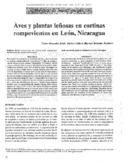Mostrar el registro sencillo del ítem
Aves y plantas leñosas en cortinas rompevientos en León, Nicaragua
| dc.contributor.author | Alvarado, Víctor | es_ES |
| dc.contributor.author | Antón, Erick | es_ES |
| dc.contributor.author | Harvey, Celia A. | es_ES |
| dc.contributor.author | Martínez, Rolando | es_ES |
| dc.date.accessioned | 2015-03-19T20:58:34Z | |
| dc.date.available | 2015-03-19T20:58:34Z | |
| dc.date.issued | 2001 | |
| dc.identifier | 463659 | es_ES |
| dc.identifier.issn | 1022-7482 | es_ES |
| dc.identifier.uri | https://repositorio.catie.ac.cr/handle/11554/5818 | |
| dc.description | 1 ilus. 3 tab. 8 ref. | es_ES |
| dc.description.abstract | Se comparó la abundancia y diversidad de aves y plantas leñosas en cortinas rompevientos en "buen estado" (5 filas de árboles y estrato inferior denso), cortinas "degradadas" (2-3 filas de árboles y estrato inferior ralo) y campos abiertos (áreas de cultivos adyacentes a las cortinas) al este de la ciudad de León, Nicaragua. Las cortinas en buen estado fueron mejores habitats para aves que cortinas degradadas y campos abiertos las cortinas degradadas y campos abiertos fueron semejantes entre si. Hubo mayor número de aves en cortinas en buen estado y más especies de aves (31 spp.) que cortinas degradadas (17 spp.) y campos abiertos (5 spp.). Los primeros parecen suministrar mejores habitats, recursos alimenticios y sitios de anidación para las aves y además fueron mejores habitats para la regeneración de plantas leñosas. Hubo mayor número de especies (19 vs 12) y una mayor densidad de plantas leñosas regenerándose en las cortinas en buen estado comparado con cortinas degradadas. Este estudio muestra que las cortinas rompevientos pueden ser importantes hábitats para aves y plantas leñosas, y que el estado de la cortina influye en la abundancia y diversidad de especies presentes. The abundance and diversity of birds and woody plants was compared in windbreaks in 'good condition' (5 rows of trees, dense understory), 'degraded' windbreaks (2-3 rows of trees, sparse understory) and open agricultural fields adjacent to the windbreaks, to the East of Leon, Nicaragua. The windbreaks in good condition were better habitats for birds than degraded windbreaks and open fields degraded windbreaks and open fields were similar to each other. There were a greater number of birds and more bird species in windbreaks in good condition (31 spp) than in degraded windbreaks (17 spp.) or in open fields (5 spp.). The former appeared to provide better habitats, food resources and nesting sites for birds and they were also better habitats for woody plant regeneration. There was a greater number of species (19 vs. 12) and a greater density of woody plants regenerating in windbreaks in good condition than in degraded windbreaks. This study shows that windbreaks can be important habitats for birds and woody plants, and that the condition of the windbreak influences the abundance and diversity of species present. | es_ES |
| dc.language.iso | es | es_ES |
| dc.publisher | CATIE, Turrialba (Costa Rica) | es_ES |
| dc.relation.ispartof | Agroforestería en las Américas (CATIE), Volumen 8, número 31, páginas 18-22 | |
| dc.rights | info:eu-repo/semantics/openAccess | |
| dc.subject | PAJAROS | es_ES |
| dc.subject | PLANTAS LEÑOSAS | es_ES |
| dc.subject | ROMPEVIENTO | es_ES |
| dc.subject | ARBOLES ROMPEVIENTOS | es_ES |
| dc.subject | REGENERACION NATURAL | es_ES |
| dc.subject | BIODIVERSIDAD | es_ES |
| dc.subject | CONSERVACION DE LA NATURALEZA | es_ES |
| dc.subject | DINAMICA DE POBLACIONES | es_ES |
| dc.subject | HABITAT | es_ES |
| dc.subject | NICARAGUA | es_ES |
| dc.title | Aves y plantas leñosas en cortinas rompevientos en León, Nicaragua | es_ES |
| dc.title.alternative | Birds and woody plants in windbreaks of León, Nicaragua | es_ES |
| dc.type | Artículo | es_ES |
| dc.journal.issueNumber | 31 |


